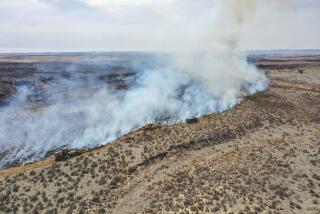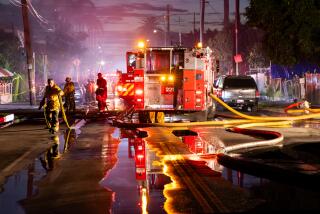Storm cell spelled doom for Arizona firefighters
PRESCOTT, Ariz. — The 19 firefighters killed this week in a rapidly advancing wildfire were battling to save a small housing subdivision and suddenly were encircled by a dense cloud of smoke and flame, according to officials familiar with the investigation.
“The only thing standing between those folks and those homes were these 19 guys up on that ridge,” said Jeff Knotek, who retired as a captain with the Prescott Fire Department on Sunday and now serves as a liaison to the family of one of the dead firefighters.
“Unfortunately, the conditions they were in were not survivable,” said Knotek, a 27-year veteran of the department who has participated in official briefings on the fire.
The account, confirmed by the Fire Department’s official spokesman, provided the first detailed explanation of what happened outside the town of Yarnell on Sunday as the 19 firefighters, members of the Prescott-based Granite Mountain Interagency Hotshot Crew, were overrun by flames rushing through the nearby manzanita and chaparral.
Knotek said the team had rushed to the defense of Glen Ilah, a subdivision about a quarter of a mile southwest of Yarnell, where homes were threatened by a lightning-ignited fire that had rapidly grown in size, fed by scorching weather and blustery winds.
The Granite Mountain crew was on a ridge above the subdivision, attempting to build a line of defense between the fire and the homes of the estimated 125 residents of the area.
Some of the men were armed with chain saws and axes, tearing down brush as quickly as they could. Others used gelled gasoline in drip torches to create a back burn.
They had made substantial progress in getting a fire line in place and had also established a safe zone and an escape route for themselves — a path they had forged between their locations and an area near the homes in Glen Ilah that they had previously cleared with a bulldozer.
But a sudden thunderstorm threw all their plans awry. The fast-moving cell sent powerful gusts of wind that changed the direction of the fire and sent clouds of smoke billowing above the firefighters’ location, according to several officials familiar with the investigation.
“It was a zero-visibility situation,” Knotek said. “They couldn’t see where or what was bottom. They met a wall of flames.… It came around and hooked them.”
Fire Department spokesman Wade Ward confirmed that the crew was working to create an anchor point against the flames when the wind shifted.
“They were creating a starting point to move out from there. The idea was to work with other crews and make a V, and get their arms around whatever was there,” he said.
The sudden arrival of the thunderstorm cell amounted to “the perfect storm,” Ward said.
Team leader Eric Marsh told his commanders via radio that the group had a predetermined safety zone. “He was calm, cool and collected,” Ward said. “They all stayed together. Nobody ran.”
Moments later — Ward doesn’t know how long — Marsh radioed his superiors a second time. This message was different: He and his men were going to deploy the small emergency shelters that were their last resort against an advancing fire.
“From what I’ve heard, it was the calmest they’ve ever heard Eric,” Ward said. “They were in a tight spot and everyone knew this was going to be a bitch. But his voice was very calm: ‘We’re deploying.’ ”
Fire officials tried desperately to save the men.
Danny Parker, a fire battalion chief from the nearby Chino Valley Fire Department whose son Wade Parker died with the other Granite Mountain crew members, said he learned from colleagues that his son was in trouble.
“They had deployed their emergency shelters, and helicopter crews were trying desperately to spot them through dense smoke,” he said, wiping tears from his eyes.
He said he was told that Sikorsky helicopters were making water drops in areas where they thought the trapped firefighters might be.
“They weren’t sure about the men’s position because they couldn’t see through the smoke,” he said.
Their bodies were found in a single group, huddled together.
“They realized they weren’t going any further,” Knotek said.
Fire officials later found widespread damage throughout Glen Ilah.
“That place is done,” said Carl Schwope, operations section chief for the Southwest Area Incident Management Team. “Everything that could burn burned.”
Ward said the crew had been briefed that morning about weather conditions they might face.
“What they didn’t know, what nobody could have predicted, was what was going to happen that day,” he said.
He praised the preparation and training of all 19 crew members. “These were not just guys who decided to sign up for an exciting job. They were men with military backgrounds, with degrees in fighting fires. They were the elite of the crop, very smart and very trained,” he said.
But Ward saved his biggest praise for Marsh.
“There’s no way Eric puts his crew in a situation where people could be compromised,” he said. “He was the most cautious supervisor out there. He had 23 years of experience. He knew what was happening. He led a team of men who engaged a fire that raged around them, in a place you would never go.”
cindy.carcamo@latimes.com
louis.sahagun@latimes.com
Times staff writers Rick Rojas and Molly Hennessy-Fiske contributed to this report.
More to Read
Start your day right
Sign up for Essential California for news, features and recommendations from the L.A. Times and beyond in your inbox six days a week.
You may occasionally receive promotional content from the Los Angeles Times.









